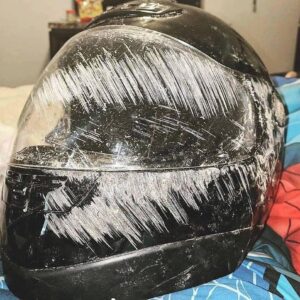Best Road Protection
When riding your motorcycle you are putting all your trust and confidence in your bike and ability. However, there is a common saying associated with motorcycling that you may have heard “There are those that have crashed and those that will”. Yes, you may have excellent motorcycle handling skills and ability, but you can’t control poor road conditions, bad weather, other road users and so on. So you always need to be prepared and protected.
Making sure y our bike is roadworthy is extremely important, but just as important is protective gear. So what is the best road protection? It can often be difficult to know what gear would save you in a life-or-death situation.
our bike is roadworthy is extremely important, but just as important is protective gear. So what is the best road protection? It can often be difficult to know what gear would save you in a life-or-death situation.
That’s why we have compiled a list of the best road protection – gear that will give you the best chance of keeping safe in the event of a misadventure on your motorcycle.
Helmets
We cannot emphasise enough – helmets are the most crucial piece of gear. Plus it is required by New Zealand law to wear one while riding.
When looking for what helmet to buy it’s wise to always check the safety rating before purchasing. Websites like SHARP provide extensive information about a wide range of helmets.
For our recommended brands to buy from, read our Best Road Helmets blog post, where we cover all of the aspects that a good helmet should have and what to know before buying a helmet.
Jackets
Working from the head down the next must-have piece of gear that all motorcycle owners should have is a protective jacket. There are many excellent options to choose from depending on your riding style, however, with so many options the choice can be quite overwhelming.
To help narrow down your choice here are some things to consider when choosing:
Built-in Armour: Most jackets will either have armour built into the actual jacket or include armour pockets so that they can be added separately and swapped out. It is a matter of personal preference which type you choose. But a non-negotiable is that you don’t buy a jacket that doesn’t have one of these two options.
If you are looking to save some money and hassle then having built-in armour is probably a smart choice for you. The thicker the better as this is what is protecting your limbs from the impact on hard surfaces.
Materials – Leather is a classic choice and there are a lot of reasons why you might want to have it as your material of choice. They often feature high-quality thick layering and heavy stitching, not to mention they last a lifetime when cared for properly. What puts people off is often that they aren’t very breathable and although you can find some with waterproofing a lot of them aren’t.
Textile is another very popular option. They come in different grades which means that there is more of a price range and differing protection levels between all of them. Some prefer textiles more than leather because they can be slightly more versatile. They often have great waterproofing and feature reflective strips, they are also lighter weight compared to leather.
Insulation and ventilation – New Zealand’s climate is unique and unpredictable, so it’s important to ensure that your jacket is built for the changeable conditions. There are a lot of jackets available that have removable linings so that you can customise your warmth level and it’s fairly easy to find a well-ventilated jacket.
Armour
As mentioned before, armour is essential and it is recommended that you treat it like you would with a helmet. You would never think of going on the road without a helmet and the same should go for armour, particularly back protection.
In the case of an accident you want to have as little damage to your body as possible so making sure that you protect all of your weakest areas is a no-brainer. Considering the importance of your spine, for example, the fact that an injury can cause not only paralysis but damage to your vital organs, back protectors are probably starting to sound more appealing. But ideally, you want to have protective armour for every joint, not just your chest and back.
Whenever we are asked what we recommend for armour our first choice would be Dririder. Their range of armour has a good balance between affordability and quality.
Pants
Surprisingly, there is more risk of injury to the legs than the upper body in a crash. Legs and feet are often forgotten about when it comes to protection because of the simple fact that if they get injured the results won’t be fatal, but that doesn’t mean that they aren’t worth protecting!
Like jackets motorcycling pants come in a wide range of materials and styles, but is often easier to determine what a good choice for you is.
Mobility – The last thing you want is to be stuck in pants that restrict your mobility and cause discomfort, especially during long rides. It’s always advised to try on the gear in person before purchasing and that is especially relevant for choosing pants.
Material – As mentioned leather by far provides the most protection due to how strong a material it is, it’s especially great protection against abrasion. A big downside to leather is the weight, for jackets that weight isn’t as much of a big deal because it is spread out more evenly, unlike pants.
Like jackets textile is also a very popular material of choice and while they do protect you from abrasion it isn’t to the same standard as leather. Why most people choose textiles is because of their lightweight properties.
Denim is an excellent choice for anyone who values both style and safety. There are plenty of options for riding jeans that look good both on and off the bike, while not compromising on your safety. They are often enforced with fabrics such as Kevlar and Cordura which provide excellent protection against abrasion. Oxford Original is a great place to start for riding jeans.
In terms of comfort, it depends on personal preference, what might be comfortable for one person might be incredibly uncomfortable for someone else. The important thing is to purchase your gear wisely and not let pricing or other people’s suggestions sway your choices.
Boots
Last but not least – boots! While riding you can’t just wear any old footwear, they simply won’t cut it. With 25% of all the bones in your body being in your feet, not to mention the hundreds of muscles, tendons and ligaments, it’s incredibly important to keep them protected.
Here is a quick rundown on what a good pair of boots should have:
Boot height – Your boots should cover your ankles at a minimum, but the taller your boots are the better protection you will have, not just to your feet but also to your legs as well.
Reinforcement – It’s a good idea to get a pair of boots that have a reinforced ankle and toe section to provide extra support to those vulnerable areas and help prevent damage to them.
Closure – Ensuring that your boots have a durable closure system and offer a firm fit will save a lot of hassle. Whether that’s laces, velcro or a zip make sure that it’s comfortable and feels natural to you.
For casual-looking boots, we suggest you check out both Dririder’s Classic Touring Boot and Oxford’s Kickback Boots. If you’re more interested in some higher protective boots have a look at Gaerne’s Prestige Gore-Tex Boot and Alpinestars Web Gore-Tex Boot.
If you have any questions or want further information get in touch with us, we would love to discuss gear with you!

